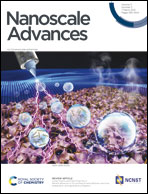Stable lead-halide perovskite quantum dots as efficient visible light photocatalysts for organic transformations†
Abstract
Lead halide perovskite (LHP) based colloidal quantum dots (CQDs) have tremendous potential for photocatalysis due to their exceptional optical properties. However, their applicability in catalysis is restricted due to poor chemical stability and low recyclability. We report halide-passivated, monodisperse CsPbBr3CQDs as a stable and efficient visible-light photocatalyst for organic transformations. We demonstrate oxidative aromatization of a wide range of heterocyclic substrates including examples which are poor hydrogen transfer (HAT) reagents. Two to five-fold higher rate kinetics were observed for reactions catalyzed by CsPbBr3CQDs in comparison with bulk-type CsPbBr3 (PNCs) or conventionally synthesized CsPbBr3CQDs and other metal organic dyes (rhodamine 6G and [Ru(bpy)3]2+). Furthermore, these CQDs exhibit improved air-tolerance and photostability and in turn show a higher turnover number (TON) of 200, compared to conventionally prepared CQDs (TON = 166) and state-of-the-art bulk-type perovskite-based catalyst (TON = 177). Our study paves the way for the practical applicability of energy-level tunable, size-controlled LHP CQDs as efficient photocatalysts in organic synthesis.



 Please wait while we load your content...
Please wait while we load your content...